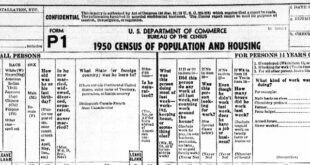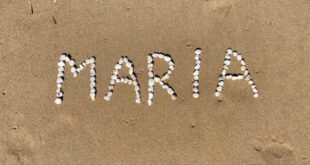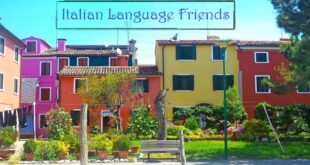 Thanks to this column, and my “check-ins” on Facebook when I am out researching somewhere, my friends know to contact me if they have a question about their Chicago or Italian heritage. I received a call from the sister of one of those friends last week. She has been bitten by the genealogy bug, and despite her best efforts, she was unable to trace her ancestry back beyond her Italian immigrant grandparents. A friend of hers had an ancestor chart back to the early 1700s and she had a case of what we genealogists call “chart envy”! So she contacted me for help.
Thanks to this column, and my “check-ins” on Facebook when I am out researching somewhere, my friends know to contact me if they have a question about their Chicago or Italian heritage. I received a call from the sister of one of those friends last week. She has been bitten by the genealogy bug, and despite her best efforts, she was unable to trace her ancestry back beyond her Italian immigrant grandparents. A friend of hers had an ancestor chart back to the early 1700s and she had a case of what we genealogists call “chart envy”! So she contacted me for help.
In the few occasions I talked about ancestry with the friend himself, we never got past the fact that his parents were both born in Chicago. The father’s parents were from Naples, and the mother’s parents were from Sicily. I asked him what towns they were from, and the answer was mumbled and vague and didn’t mention a town at all, which is frequently the answer most second-generation Americans have when you ask what town their grandparents were born in.
In order to trace their shared ancestry back another generation, the first step is to work with Italian records and in order to do that, one must know the name of the small town they came from. The usual first step in finding out the name of the town is to ask them, and since that failed to produce an answer, I had to proceed to step two. I didn’t even know the names of the grandparents, and I could have easily asked them, but I enjoy the challenge of figuring it out for myself. Years before, I had been to St. Joseph Cemetery in River Grove looking for another family member of mine along the fence that runs down Cumberland Avenue, and I found most of my friend’s family by accident. His parents, brother and sister are buried together. So even though I never met his parents, I knew their names. So I needed the names of the grandparents. Based on the birth years that were on the gravestones of his parents, I knew I could find them in the Cook County vital records on familysearch.org.
This would all be a much easier process if everyone knew how to spell correctly and consistently. However, as I have mentioned in many a column, we can’t always trust the spelling of the county clerk, when he is told what to write by our frequently illiterate ancestors (or their midwives who delivered the babies).
So I looked for the birth certificates in the index, and found both. I wrote the parents’ names from each certificate, and good luck was with me because the birth towns of the parents were also listed in the index. (The birth certificates from Cook County in the early part of the century ask for the birthplace of the father and mother of the new infant. The vast majority of them only list the name of the country they came from.)
So I have the names, ages, and birth towns of the four grandparents of my friend and his sister. Great! Hmm. … We have some problems here. …The towns that were listed on the documents were spelled in such a way that you could not turn them into an Italian town name even if you rearranged all the letters! I was not able to track down a town in Naples or Sicily that came even close to these. I need another source. I presumed that the grandparents all died in Chicago, since they had children born here. I know you cannot always presume this, but I needed to see if the death certificates existed and if they might have a different spelling of the birth town.
After a battle with the spellings of the surnames, I did finally find the death certificates of all four grandparents in Chicago. Even though familysearch will take a name and find the perfect matches first, then less perfect, then close, then less close, and finally “way off”! None of these worked, so I had to search for first names only, and clicked “spouse” and entered their first name only. So I was looking for anyone named Vincenzo who was married to anyone named Carmela, who died in Chicago. I think it’s safe to say that there are quite a few couples that fit this description! I had no year of death to check, because I did not accidentally trip over the graves of the grandparents at any point. I did find Carmela first, and the index told me that she was married, not widowed, at the time of her death in 1932. So I knew that I could narrow my search for Vincenzo to years after 1932, which removed a number of records from the list.
And then I ran into the obvious problem we have to deal with as Italian genealogists. Some first names change beyond recognition. I could not find Vincenzo married to Carmela with anything that looked like the correct surname, and then it dawned on me that many Vincenzos from Italy end up being called “James.”
Not every genealogy web site can deduce that when I search for Vincenzo, it should show me results that include James. Same thing with searching for Giovanni and showing John, Giuseppe-Joseph, Pasquale-Patsy, Pasquale-Charles, Carlo-Charles, Vito-Victor etc. The search programs usually take out vowels after showing the perfect and less-than-perfect results, but they rarely change the name to match ethnic derivatives. So after searching in vain for Vincenzo husband of Carmela, I had a “duh” moment and searched for James married to Carmela instead, and bingo!
Now that I found the four grandparents in the death index, I was reminded first of the fact that many death certificates do not list what we need. It would have been a major find if the death certificates of the grandparents listed THEIR parents, but alas, the parents were “unknown” and the birth town of the deceased was also “unknown Italy.” The good news was that I found the death dates of the four grandparents, but I was still unable to find the correct towns of birth. All I had was the misspelled version from the birth index. Now what?
I usually like to try the naturalizations at this point. There is quite a bit of detail on the petition for naturalization form, and sometimes there are photographs (head shots) of the petitioner. I searched for all four grandparents and though they lived in Chicago for decades, none of them filed for citizenship. On these federal documents, they took a little more effort to clean up the spellings. For example, the passenger list has to be found, to link the passenger with the person filing for citizenship. The immigrant did not want to end up deported, and they genuinely feared this, not knowing any better. So the goal was to be as accurate as possible. They did not have this pressure when filing a birth or death certificate.
So my friend’s sister is hoping for more generations, but all I was able to do was find the names of her grandparents that she already knew, death dates for them, and a couple of unidentifiable birth towns in Italy. I have no citizenship papers to help me with the town names. Now what do I do? What other sources can I use to break the logjam and lead her to Italian records that can take her ancestry back several generations?
Tune in next month for the conclusion to this perplexing episode!
If you have any questions, send me an e-mail at italianroots@comcast.net and please put “Fra Noi” in the subject line. Have fun!
 Fra Noi Embrace Your Inner Italian
Fra Noi Embrace Your Inner Italian





